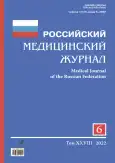Синдром фолликулярной окклюзии в практике врача-колопроктолога
- Авторы: Шлык Д.Д.1, Илюхина Ю.А.2, Пирогова А.С.1, Киценко Ю.Е.1, Тулина И.А.1, Теплюк Н.П.1, Царьков П.В.1
-
Учреждения:
- Первый Московский государственный медицинский университет им. И.М. Сеченова (Сеченовский Университет)
- Медицинский центр «Он клиник»
- Выпуск: Том 28, № 6 (2022)
- Страницы: 465-473
- Раздел: Клинический случай
- Статья получена: 22.11.2022
- Статья одобрена: 29.11.2022
- Статья опубликована: 03.01.2023
- URL: https://medjrf.com/0869-2106/article/view/114803
- DOI: https://doi.org/10.17816/medjrf114803
- ID: 114803
Цитировать
Полный текст
Аннотация
Обоснование. Пилонидальная болезнь, или эпителиальный копчиковый ход (ЭКХ), — четвёртое по распространённости заболевание среди колопроктологических пациентов в стационаре, при этом «золотым стандартом» лечения является хирургическое вмешательство. Однако зачастую пациенты с ЭКХ имеют сочетанные проявления синдрома фолликулярной окклюзии (СФО), с которыми наиболее часто сталкиваются в своей практике врачи-дерматовенерологи. В большинстве случаев СФО в сочетании с пилонидальной болезнью вызывает трудности в диагностике и лечении в рамках одной специальности. Цель данной публикации — продемонстрировать сложность диагностики нозологий из группы СФО в сочетании с ЭКХ, систематизировать диагностический протокол ведения таких пациентов и представить выбранную тактику лечения в рамках специальности врача-колопроктолога.
Описание клинического случая. В Клинике колопроктологии и малоинвазивной хирургии Сеченовского Университета (Москва) отмечено наблюдение ЭКХ в сочетании с СФО. Первым этапом проведено хирургическое лечение. В раннем послеоперационном периоде осложнений не было. После выписки из стационара пациент проконсультирован врачом-дерматовенерологом, назначена местная и системная консервативная терапия по поводу сочетанных заболеваний, на фоне проведения которой наблюдалась выраженная положительная динамика. В настоящее время рецидива не отмечено.
Заключение. Лечение СФО, где одним из проявлений является наличие пилонидальной болезни, требует мультидисциплинарного подхода. При этом для лечения ЭКХ оптимальным методом является хирургическое вмешательство с радикальным иссечением всех изменённых тканей. В случае таких заболеваний, как гнойный гидраденит, конглобатные акне, рассекающий целлюлит волосистой части головы, лечение должно быть комплексным и начинаться у дерматовенеролога.
Ключевые слова
Полный текст
Об авторах
Дарья Дмитриевна Шлык
Первый Московский государственный медицинский университет им. И.М. Сеченова (Сеченовский Университет)
Email: shlikdarya@gmail.com
ORCID iD: 0000-0002-9232-6520
SPIN-код: 4948-3550
к.м.н., доцент
Россия, МоскваЮлия Алексеевна Илюхина
Медицинский центр «Он клиник»
Email: iluhinaulia@gmail.com
ORCID iD: 0000-0002-3963-6407
врач-колопроктолог
Россия, МоскваАнна Сергеевна Пирогова
Первый Московский государственный медицинский университет им. И.М. Сеченова (Сеченовский Университет)
Email: annese@mail.ru
ORCID iD: 0000-0002-2246-1321
SPIN-код: 1419-2147
аспирант
Россия, МоскваЮрий Евгеньевич Киценко
Первый Московский государственный медицинский университет им. И.М. Сеченова (Сеченовский Университет)
Автор, ответственный за переписку.
Email: kitsenko@kkmx.ru
ORCID iD: 0000-0002-4415-6141
SPIN-код: 4673-1926
к.м.н., доцент
Россия, 119991, Москва, ул. Б. Пироговская, 2, стр. 4Инна Андреевна Тулина
Первый Московский государственный медицинский университет им. И.М. Сеченова (Сеченовский Университет)
Email: tulina@kkmx.ru
ORCID iD: 0000-0002-6404-389X
SPIN-код: 7746-1226
к.м.н., доцент
Россия, МоскваНаталья Павловна Теплюк
Первый Московский государственный медицинский университет им. И.М. Сеченова (Сеченовский Университет)
Email: teplyukn@gmail.com
ORCID iD: 0000-0002-5800-4800
SPIN-код: 8013-3256
д.м.н., профессор
Россия, МоскваПетр Владимирович Царьков
Первый Московский государственный медицинский университет им. И.М. Сеченова (Сеченовский Университет)
Email: tsarkov@kkmx.ru
ORCID iD: 0000-0002-7134-6821
SPIN-код: 7570-0664
д.м.н., профессор
Россия, МоскваСписок литературы
- Справочник по колопроктологии / под ред. Ю.А. Шелыгина, Л.А. Благодарного. Москва : Литтерра, 2012.
- Al-Khamis A., McCallum I., King P.M., Bruce J. Healing by primary versus secondary intention after surgical treatment for pilonidal sinus // Cochrane Database Syst Rev. 2010. Vol. 2010, N 1. P. CD006213. doi: 10.1002/14651858.CD006213.pub3
- Chintapatla S., Safarani N., Kumar S., Haboubi N. Sacrococcygeal pilonidal sinus: historical review, pathological insight and surgical options // Tech Coloproctol. 2003. Vol. 7, N 1. P. 3–8. doi: 10.1007/s101510300001
- Akinci O.F., Kurt M., Terzi A., et al. Natal cleft deeper in patients with pilonidal sinus: implications for choice of surgical procedure // Dis Colon Rectum. 2009. Vol. 52, N 5. P. 1000–1002. doi: 10.1007/DCR.0b013e31819f6189
- Gasparic J., Theut Riis P., Jemec G.B. Recognizing syndromic hidradenitis suppurativa: a review of the literature // J Eur Acad Dermatol Venereol. 2017. Vol. 31, N 11. P. 1809–1816. doi: 10.1111/jdv.14464
- Garg A., Kirby J.S., Lavian J., et al. Sex- and age-adjusted population analysis of prevalence estimates for hidradenitis suppurativa in the United States // JAMA Dermatol. 2017. Vol. 153, N 8. P. 760–764. doi: 10.1001/jamadermatol.2017.0201
- Petersen S., Koch R., Stelzner S., et al. Primary closure techniques in chronic pilonidal sinus: a survey of the results of different surgical approaches // Dis Colon Rectum. 2002. Vol. 45, N 11. P. 1458–1467. doi: 10.1007/s10350-004-6451-2
- Fox S. The origin of pilonidal sinus // Surgery, Gynecology and Obstetrics. 1935. Vol. 60. P. 137–140.
- Дульцев Ю.В., Ривкин В.Л. Эпителиальный копчиковый ход. Москва : Медицина, 1988. 129 c.
- Ривкин В.Л. Эпителиальный копчиковый ход — рудиментарный остаток хвоста, причина крестцово-копчиковых нагноений // Наука и мир. 2015. № 9-1. C. 127.
- Оганесян С.3. Эпителиальные ходы и кисты копчиковой области. Ереван : Айастан, 1970. 183 c.
- Plewig G., Kligman A.M. Acne: morphogenesis and treatment. Berlin : Springer-Verlag, 1975. 332 p.
- Bascom J. Pilonidal disease: origin from follicles of hairs and results of follicle removal as treatment // Surgery. 1980. Vol. 87, N 5. P. 567–572.
- Luz Ramos M., Muñoz-Pérez M.A., Pons A., et al. Acne keloidalisnuchae and tufted hair folliculitis // Dermatology. 1997. Vol. 194, N 1. P. 71–73. doi: 10.1159/000246063
- Padilha-Gonçalves A. Infl ammatory tineacapitis (kerion) mimicking dissecting cellulitis // Int J Dermatol. 1992. Vol. 31, N 1. P. 66. doi: 10.1111/j.1365-4362.1992.tb03526.x
- Sperling L.C. Infl ammatory tineacapitis (kerion) mimicking dissecting cellulitis. Occurrence in two adolescents // Int J Dermatol. 1991. Vol. 30, N 3. P. 190–192. doi: 10.1111/j.1365-4362.1991.tb03849.x
- Scheinfeld N. An atlas of the morphological manifestations of hidradenitis suppurativa // Dermatol Online J. 2014. Vol. 20, N 4. P. 22373.
- Hendricks A.J., Hsiao J.L., Lowes M.A., Shi V.Y. A comparison of international management guidelines for hidradenitis suppurativa // Dermatology. 2021. Vol. 237, N 1. P. 81–96. doi: 10.1159/000503605
- Vasanth V., Chandrashekar B.S. Follicular occlusion tetrad // Indian Dermatol Online J. 2014. Vol. 5, N 4. P. 491–493. doi: 10.4103/2229-5178.142517
- Musumeci M.L., Fiorentini F., Bianchi L., et al. Follicular occlusion tetrad in a male patient with pachyonychia congenita: clinical and genetic analysis // J Eur Acad Dermatol Venereol. 2019. Vol. 33, Suppl 6. P. 36–39. doi: 10.1111/jdv.15851
Дополнительные файлы










